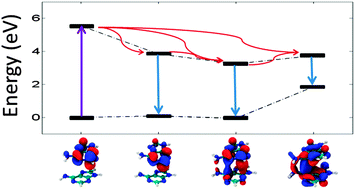Photophysical deactivation pathways in adenine oligonucleotides†
Abstract
In this work we study deactivation processes in adenine oligomers after absorption of UV radiation using Quantum Mechanics combined with Molecular Mechanics (QM/MM). Correlated electronic structure methods appropriate for describing the excited states are used to describe a π-stacked dimer of adenine bases incorporated into (dA)20(dT)20. The results of these calculations reveal three different types of excited state minima which play a role in deactivation processes. Within this set of minima there are minima where the excited state is localized on one adenine (monomer-like) as well as minima where the excited state is delocalized on two adenines, forming different types of excimers and bonded excimers of varying but inter-related character. The proximity of their energies reveals that the minima can decay into one another along a flat potential energy surface dependent on the interbase separation. Additionally, analysis of the emissive energies and other physical properties, including theoretical anisotropy calculations, and comparison with fluorescence experiments, provides evidence that excimers play an important role in long-lived signals in adenine oligonucleotides while the subpicosecond decay is attributed to monomer-like minima. The necessity for a close approach of the nucleobases reveals that the deactivation mechanism is tied to macro-molecular motion.


 Please wait while we load your content...
Please wait while we load your content...